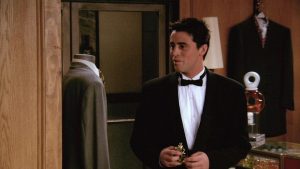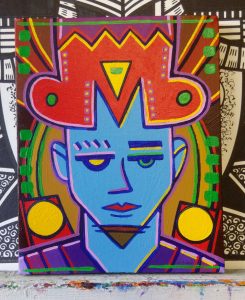I think I’ll sit down and write as I watch an episode of “Friends.” This time it’s “The One With the Breast Milk.” That’s Season Two and episode two. It was originally broadcast on September 28, 1995. I watched it as it originally aired way back then. From my calendar I can see that I worked down in Manhattan at Marvel Comics that day. I also checked my photo archive and can see that I spent a night that month (exact date unknown ) hanging out with my friends at Ace Bar down on 5th Street in Manhattan. That place is still open. Enough of what I was doing. Let’s see what’s going on in this one.
It starts out with an establishing shot of the corner of Bedford and Grove Streets in NYC. Somehow I’ve managed to never pay attention to the street that the Friends lived on. Isn’t that weird? If I hadn’t paused the show at the beginning of this episode I might have continued not to pay attention to it. Maybe it’s because I know the show wasn’t filmed in NYC so I haven’t payed attention to those landmarks. They don’t really have any connection to the show since it was filmed out in California.
That’s right Ross and Carol had their baby. Everyone is gathered in the apartment to ogle the child. Look. Tiny sneakers. Phoebe is such a weirdo. I dig her. Uh-oh, the boys are uncomfortable with breast feeding. Nothing too funny here but Joey’s balloon joke is good. And here comes the theme song. Not a lot of great theme songs left on TV. This was one of them from days gone by.
Now a scene with Rachel at work in Central Perk. Ross’s new girlfriend Julie is there. I liked Julie. I liked her better than Rachel. This whole scene is about how Rachel is jealous of Julie and neither Ross or Julie even know. The whole gang is at Central Perk and it’s a pretty good scene. Lots of banter. Ross is so happy and Rachel just has to ruin it.
Next scene is Joey at one of his many temp jobs. He’s dressed in a tux and hustling perfume at a department store. I was never envious of any of Joey’s temp jobs but at least he got to socialize with the pretty women of the store in this one. Here comes another perfume hustler. The Hombre hombre. I always like this bit. Someone the chicks dig more than Joey shows up and it makes him insecure. The guy who plays the hombre does an excellent job of it. One of my favorite never-to-be-seen-again characters.
Back to Central Perk. Monica has to hide that she was out shopping with Julie from Rachel or Rachel will get jealous. Never my favorite plot. Phoebe is not good at lying and messes it all up. She can lie just fine when she wants to though.
We cut back to Joey and the girl he was chatting up (Annabelle) tells him that she can’t grab a bite to eat because she’s going out with the hombre. Jealousy seems to be a theme in this episode as both Joey and Rachel are drinking from the jealousy bottle.
More baby jokes at the apartment. Monica makes some off color jokes to try to keep Rachel from being jealous. That was a quick scene. Now we get to the title of the episode as first Phoebe and then Joey try some of the baby’s bottle that’s filled with breast milk. Everybody else is grossed out. This is a pretty fast moving episode.
Now Monica and Rachel get their own scene in the apartment. Rachel finds out about Monica and Julie having lunch despite Monica lying about it. Rachel is not happy. This is a goofy fun scene. They’re playing it like Monica is cheating on Rachel. Lot’s of double entendres in this dialogue.
Next scene. More Monica stuff and then we get more baby stuff. Here we go with the breast milk jokes. Ross is digging himself a hole with his ex-wife as her girlfriend/partner Susan watches. Amusing. “This should be fun” is a good line from Susan. Chandler with the joke. Now Ross is jealous of Susan. I’ve always liked the Ross and Susan dynamic.
Joey comes into his apartment dressed in a white cowboy outfit. The Hombre from before was dressed in all black. Joey continues his envy and Chandler serves him a drink and imitates a bartender from an old western movie. Joey is doubting his cologne selling chops. Fun silliness.
Rachel is the most annoying of the friends. She’s got her and Monica crying. They cry/talk to each other for a while but Phoebe steals the scene. Phoebe is a good scene stealer. A breath of fresh air in the unfunny drama parts.
Back to the department store and it’s an hombre vs.hombre showdown. The black and white outfits remind me of Mad Magazine’s “Spy vs. Spy.” Turns out the hombre’s name is really Todd and his tough cowboy facade gets broken down and Joey rides off into the sunset with Annabelle. I’ll miss that hombre.
Now we get a resolution scene with Rachel and Julie. It’s an uncomfortable scene but at least Rachel is trying. As annoying as she is she usually redeems herself. But then she throws it all away with a funny line. Hey, if you’re going to throw it all away you may as well be fully about it.
The after credits scene is Ross with a bottle of breast milk and cookies. Can he do it? Will he drink the milk? Chandler and Joey are there too and are impatient. He does it. Drinks and quickly jams cookies in his mouth.
After watching the episode I went and did my usual thing. I watch the old DVD versions of the shows because they are the extended editions. The HD ones that run on TV and Netflix are missing stuff. Sometimes really good stuff. This episode only had one sentence cut from it so it’s not missing much. I could have watched the HD version and not even have noticed anything missing.






